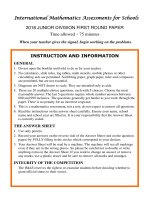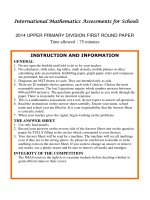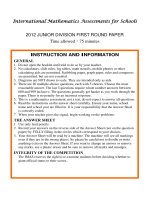iinntteerrnnaattiioonnaall mmaatthheemmaattiiccss aasssseessssmmeennttss ffoorr sscchhoooollss
Bạn đang xem bản rút gọn của tài liệu. Xem và tải ngay bản đầy đủ của tài liệu tại đây (91.85 KB, 8 trang )
<span class='text_page_counter'>(1)</span><div class='page_container' data-page=1>
<i><b>When your teacher gives the signal, begin working on the problems. </b></i>
2018 MIDDLE PRIMARY DIVISION FIRST ROUND PAPER
Time allowed
:
75 minutes
<b>INSTRUCTION AND INFORMATION </b>
<b>GENERAL </b>
1. Do not open the booklet until told to do so by your teacher.
2. No calculators, slide rules, log tables, math stencils, mobile phones or other
calculating aids are permitted. Scribbling paper, graph paper, ruler and compasses
are permitted, but are not essential.
3. Diagrams are NOT drawn to scale. They are intended only as aids.
4. There are 20 multiple-choice questions, each with 5 choices. Choose the most
reasonable answer. The last 5 questions require whole number answers between
000 and 999 inclusive. The questions generally get harder as you work through the
paper. There is no penalty for an incorrect response.
5. This is a mathematics assessment, not a test; do not expect to answer all questions.
6. Read the instructions on the answer sheet carefully. Ensure your name, school
name and school year are filled in. It is your responsibility that the Answer Sheet
is correctly coded.
<b>THE ANSWER SHEET </b>
1. Use only pencils.
2. Record your answers on the reverse side of the Answer Sheet (not on the question
paper) by FULLY filling in the circles which correspond to your choices.
3. Your Answer Sheet will be read by a machine. The machine will see all markings
even if they are in the wrong places. So please be careful not to doodle or write
anything extra on the Answer Sheet. If you want to change an answer or remove
any marks, use a plastic eraser and be sure to remove all marks and smudges.
<b>INTEGRITY OF THE COMPETITION </b>
The IMAS reserves the right to re-examine students before deciding whether to
grant official status to their scores.
<i>I</i>
</div>
<span class='text_page_counter'>(2)</span><div class='page_container' data-page=2></div>
<span class='text_page_counter'>(3)</span><div class='page_container' data-page=3>
2018 MIDDLE PRIMARY DIVISION FIRST ROUND PAPER
<b>Questions 1-10, 3 marks each </b>
1. 1. What is the value of 19 1 19 3 19 5 19 7× + × + × + × +"+ ×19 19?
(A)1900 (B)1919 (C)2900 (D)2919 (E)3800
2. If (Δ × − × =2 1) 2 2018, then what is the value of Δ?
(A)502 (B)503 (C)504 (D)505 (E)506
3. Five students sit along a circle and starts to call out some numbers one-by-one.
Student A calls out “1”, B calls out “2”, C calls out “3”, D calls out “4”, E calls
out “5” and then it returns back to Student A who calls out “6” and so on, where
each student increases the previously called number by one and calls it out.
Which student calls out the number “99”?
(A)A (B)B (C)C (D)D (E)E
4. In the figure shown below, four rectangles of the same size, denoted by I, II, III
and IV, are placed together, where<i> ABCD</i> and <i>EFGH</i> are both squares. If
rectangle I has a perimeter of 20 cm, then what is the perimeter, in cm, of
<i>ABCD</i> ?
(A)40 (B)60 (C)80 (D)100 (E)120
5. How many triangles in total are there in the figure below?
(A)4 (B)8 (C)12 (D)14 (E)16
<i>C </i>
<i>D </i>
<i>B </i>
<i>A </i>
<i>G </i>
<i>H </i>
<i>F </i>
<i>E </i> <sub>II </sub>
I
</div>
<span class='text_page_counter'>(4)</span><div class='page_container' data-page=4>
6. The six faces of a cube are colored using six different colors namely red, blue,
yellow, green, black and white in some order. Turn the cube arbitrarily and it
shows the two possible scenarios below. What is the color opposite to the face of
green?
(A)Red (B)Yellow (C)Blue (D)Black (E)White
7. Consider every positive integers whose digits do not include 2 and that sum of its
digits is equal to 3 and arrange all such integers in increasing order. What is the
sum of the three smallest integers that satisfy the conditions?
(A)36 (B)63 (C)144 (D)206 (E)414
8. In the 4 4× square table shown below, a △ is placed on the second row and
second column. What is the total number of squares with sides falling on the grid
lines and containing △?
△
(A)8 (B)10 (C)11 (D)12 (E)14
9. In the figure below, a frog jumps between the three circles. In each jump, it goes
from one circle into another circle. It is known that the frog starts from <i>A</i> and
ends at <i>A</i> after 4 jumps. How many different paths can the frog have?
(A)4 (B)5 (C)6 (D)7 (E)8
10. In 1202 A.D., Italian mathematician Fibonacci (1170~1250) wrote in his book
《Liber Abaci》 the following interesting problem: Exactly two months after
their birth, a pair of rabbits will give birth to a new pair (one male and one
female) and then give birth to a pair each month after that. There is only one pair
of new born rabbits at the beginning. If the rabbits never die, how many pair of
rabbits are there after exactly 12 months?
(A)144 (B)233 (C)234 (D)235 (E)377
MP 2
<i>C</i>
<i>A </i> <i>B</i>
<i><b>Blac</b></i> <i><b>Blue</b></i>
<i><b>Red</b></i>
<i><b>Red</b></i> <i><b>Yellow</b></i>
</div>
<span class='text_page_counter'>(5)</span><div class='page_container' data-page=5>
<b>Questions 11-20, 4 marks each </b>
11. Define “*” as an operation such that 4 2∗ =82, 6 3 183∗ = , 8 4∗ =324 ,
9 3∗ =276 and 9 5∗ =454. What is the value of 10 2∗ ?
(A)55 (B)125 (C)202 (D)208 (E)2002
12. Bob got a score of 94 on foreign language test, and his average score on the
native language and math tests is 97. What is his average score on these three
tests?
(A)94 (B)94.5 (C)95 (D)95.5 (E)96
13. Color the surfaces of a 5 5 5× × wooden cube red, then cut it into smaller 1 1 1× ×
cube pieces. How many of these smaller cubes have exactly two red faces?
(A)36 (B)48 (C)61 (D)90 (E)98
14. A palindrome number is a positive integer that is the same when read forwards or
backwards. The numbers 909 and 1221 are examples of palindromes. How many
palindrome numbers are there between 10 and 1000?
(A)90 (B)99 (C)100 (D)106 (E)108
15. In the month of February of some year, there are more Saturdays than any other
days in a week. What day is the last day of this month?
(A)Wednesday (B)Thursday (C)Friday
(D)Saturday (E)Sunday
16. Four students namely Annie, Benny, Charlie and Deany all paid the same amount
of money to buy some number of notebooks together. After distributing the
notebooks, Annie, Benny and Charlie got 6, 7 and 11 notebooks more than Deany,
respectively. As such, to be fair, Annie, Benny and Charlie gave back a total of
$48 to Deany. What is the price of each notebook?
(A)2 (B)6 (C)8 (D)12 (E)16
17. A train left town A at 8:30 AM some day and arrived at town B at 1:50 AM of the
next day. There is no time difference between the two places. How long did the
train travelled for the trip?
(A)5 hours 20 minutes (B)10 hours 20 minutes(C)15 hours 20 minutes
</div>
<span class='text_page_counter'>(6)</span><div class='page_container' data-page=6>
18. Mike placed 4 identical squares, each with side length 5 cm and are
non-overlapping, to form a new figure as shown below. Find the perimeter, in cm,
of this new figure.
(A)15 (B)20 (C)30 (D)45 (E)50
19. Adam owns an old watch, which is slower than a normal watch by the same
amount of time for each hour. At 8 o'clock in the morning, the old watch reads 8
o'clock. At 9 o'clock in the morning, it reads 8:58. What time does it read when
the real time is 4 o'clock in the afternoon?
(A)3:42 (B)3:44 (C)3:46
(D)4:08 (E)4:16
20. Identical equilateral triangles are placed together into two figures as shown below.
One can cover Figure B using 5 pieces of Figure A. How many different ways
can we do the covering?
(A)3 (B)4 (C)5 (D)6 (E)7
<b>Questions 21-25, 6 marks each </b>
21. Put some unit cubes into a 3D model such that in the model, each cube touches
some other cubes in at least one point. It is known that the model looks like the
figure below from three directions of upright front, left and top. What is the least
number of unit cubes needed to make such a model?
MP 4
Figure A
</div>
<span class='text_page_counter'>(7)</span><div class='page_container' data-page=7>
22. How many ways can we divide 6 students into 3 groups so that each group has
exactly 2 students?
23. In the figure below, <i>ABCD</i>, <i>EFGH</i> and <i>AJKL</i> are squares. The area of <i>AJKL</i> is
2018 cm2. If rectangles <i>EFCI</i> and <i>JBFK</i> both have an area of 1360 cm2, then
what is the area, in cm2, of <i>CGHI</i>?
24. Three pairs of red, four pairs of yellow and five pairs of white socks are placed in
a bag. Now, blindly take a sock out each time. How many socked are needed to
be taken out to guarantee having six pairs of socks? (Note: Two socks of the
same color are considered a pair)
25. Cut the 6 6× square table below into rectangles along grid lines such that no
two rectangles are identical. What is the maximum number of rectangles one can
get? (Note: A square is considered a rectangle.)
***
MP 5
<i>C </i>
<i>B </i>
<i>L </i>
<i>A </i>
<i>G </i>
<i>I </i>
<i>F </i>
<i>E </i> <i>H </i>
<i>D </i>
</div>
<span class='text_page_counter'>(8)</span><div class='page_container' data-page=8></div>
<!--links-->









